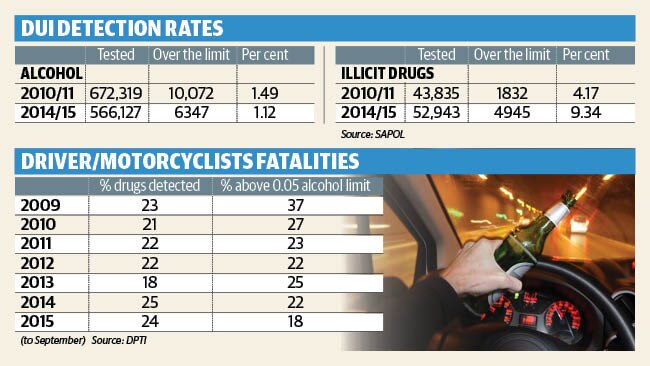Drug-driving rates in South Australia rises to record levels
MORE drivers killed on the state’s roads are testing positive to drugs than alcohol, road crash figures show — as a record number of drug drivers are being busted.

SA News
Don't miss out on the headlines from SA News. Followed categories will be added to My News.
- Inside Australia’s drug epidemic: how ice is tearing our country apart
- 9000km trip through the heart of our Ice Nation
- ‘Meth is everywhere in Adelaide. It’s huge’
MORE drivers killed on the state’s roads are testing positive to drugs than alcohol, road crash figures show.
The revelation comes as a record number of drug drivers are being busted by police, whose latest figures show detection rates have more than tripled since roadside testing began a decade ago.
Police blamed increasing illegal drug use in the community for contributing to the almost 5000 drivers caught high on ice, cannabis and ecstasy last financial year.
Among those caught were parents dropping their children off at school.
The Motor Accident Commission says the increasing danger of drugs on the roads will be the focus of a new awareness campaign in the hope it can emulate the success of anti drink-driving campaigns.
MAC general manager of road safety Michael Cornish said drug driving was a “major concern’’ and that “the statistics speak for themselves’’.
“Between 2010 and 2014, 21 per cent of drivers or riders killed on our roads had illegal drugs in their system,” he said.
“Of those fatalities, five times more men than women lost their lives in crashes involving illegal drugs’’.
“MAC has championed anti drink-and-drive messages to South Australians for more than a decade, building awareness of the dangers and influencing driver behaviours.
“While we will continue our drink-drive campaigns, MAC is also developing a new campaign with a drug driving focus.”

Superintendent Anthony Fioravanti, the officer in charge of the Traffic Support Branch, warned drivers their mental alertness, concentration and reaction times were impaired while on drugs.
“Contributing to the high drug detection rate is the fact that traffic enforcement officers right across South Australia are now specifically trained to conduct the tests, so detection can occur anytime, anywhere,’’ he said.
“Improving technology also increases our effectiveness.’’
Supt Fioravanti also said that “it is also likely that the increase in drug drive detections reflects an increase in the usage of illicit drugs’’.
Almost one-in-ten drivers tested for drug driving last financial year returned a positive result.
Five years ago, the rate was less than one in twenty.
And drugs are now taking a greater toll of drivers and motorcyclists than drink on our roads, according to Transport Department figures.
They show drugs were detected in 24 per cent of driver/rider fatalities in the first nine months of last year, compared to 18 per cent over the alcohol limit. Of the 59 driver and riders who died, 33 were tested and six were over the .05 alcohol limit, while eight tested positive to drugs.
In 2014 — the first year more fatality victims were detected high than drunk, the rates were 25 per cent and 22 per cent respectively.
It is known that some of the dead tested positive to both alcohol and drugs, although a breakdown of these was not available.
Supt Fioravanti said drug-driving detection was “relatively new’’ compared to alcohol testing, but it was becoming more effective due to “intelligence-led’’ targeting of locations where drug users were more likely to be found on the roads.
Drink-driving detection rates have fallen in the past five years, from 1.49 per cent of all drivers tested to 1.12 per cent.
Supt Fioravanti said this was “an important indicator for police and may demonstrate ongoing improvement in driver behaviour’’.
“SAPOL believes this is as a result of the level of alcohol screening and mix of specific and general deterrent tactics,’’ he said.
The MAC’s Mr Cornish said the most common type of crash by drivers who were high or drunk involved “losing control of the vehicle and hitting a fixed object such as a tree, Stobie pole or other property’’.
“Research also indicates that more drug-driving related fatal crashes occur in regional South Australia, a consistent trend with alcohol-related fatalities,’’ he said.


